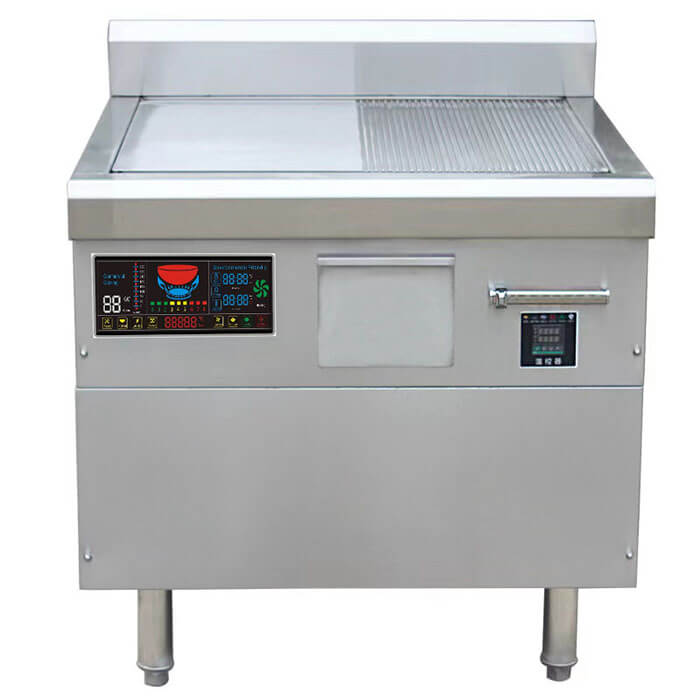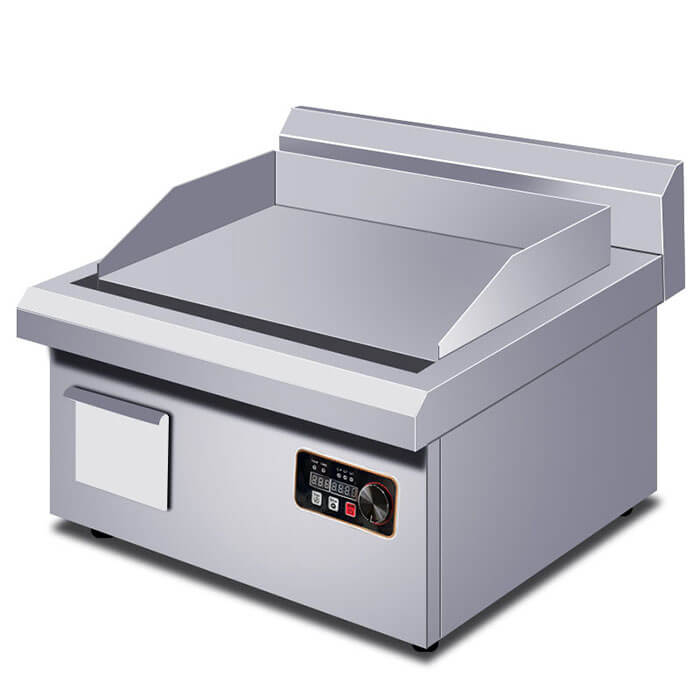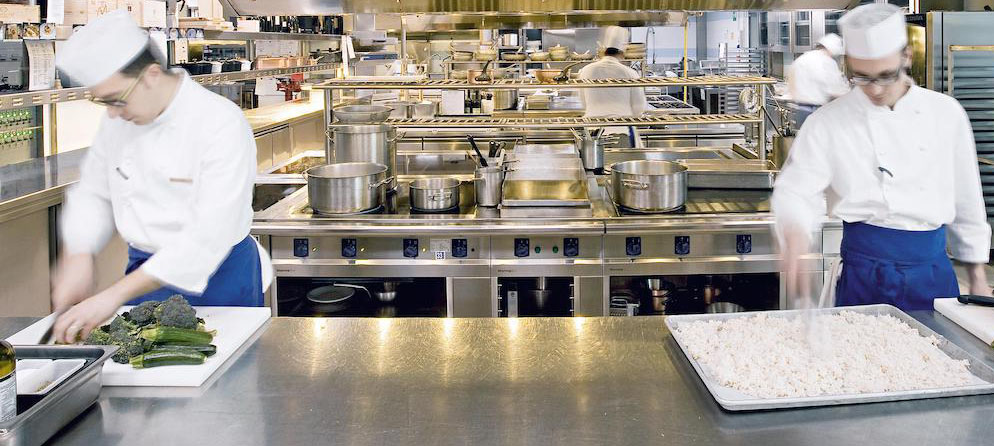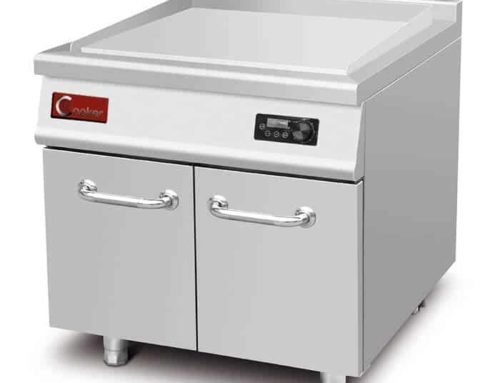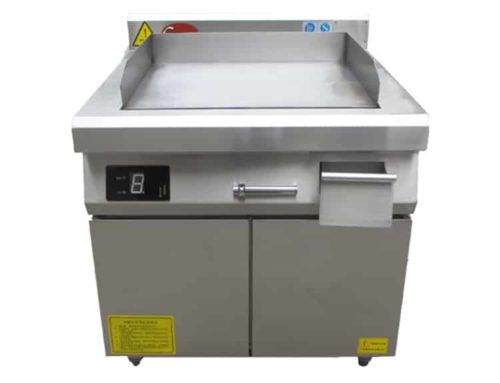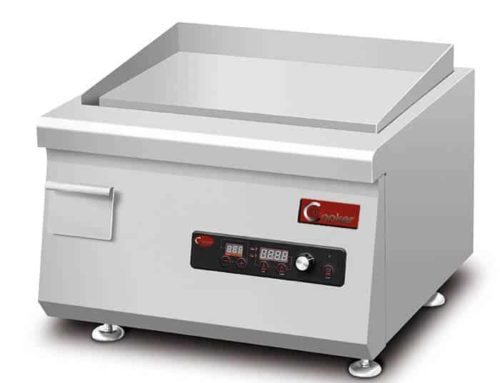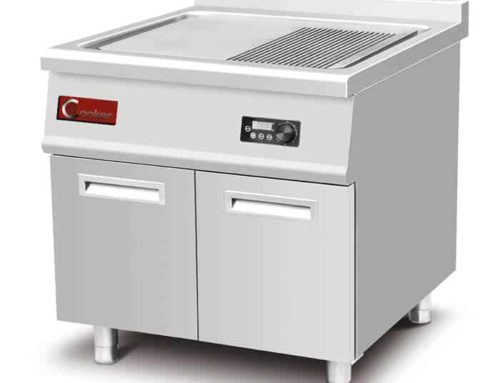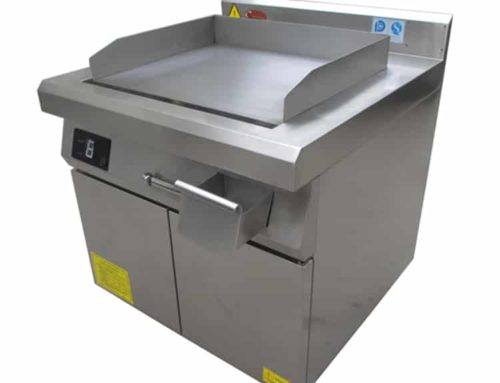Commercial Griddles: Energy Efficiency Ratings & AT Cooker’s Electric Flat Grill Top
Yes—while formal energy efficiency ratings for commercial griddles lack universal standardization, measurable indicators (like efficiency percentages, heat loss data, and third-party certifications) exist to evaluate performance. For businesses investing in an electric flat grill top, these metrics are critical: AT Cooker’s 2024 survey of 170 restaurant operators found that energy-efficient commercial griddles cut monthly utility bills by $150–$300, a 18–25% reduction compared to inefficient models. This guide breaks down energy efficiency ratings for commercial griddles, highlights how AT Cooker’s induction commercial griddle (QRPLT-A5F5A, our top-selling model) outperforms traditional electric flat top griddle options, and explains how to compare efficiency even without standardized labels.
Induction Tech (vs. Resistive Heating)
Insulated Panels (20% Less Heat Loss)
Soft-Start Tech (Reduced Startup Energy)
1. No Universal Standardization—But Measurable Metrics Exist
Unlike residential appliances, commercial griddles (including electric flat grill top models) lack a single standardized energy efficiency rating system (e.g., a universal “star rating”). This is because commercial use varies drastically (8–12 hours/day for diners vs. 4–6 hours/day for cafes), making one-size-fits-all ratings less meaningful. However, manufacturers like AT Cooker provide verifiable efficiency data—such as induction efficiency percentages, heat loss rates, and power consumption per hour—to help buyers compare models.
For example, AT Cooker’s QRPLT-A5F5A induction griddle has a published efficiency rating of 90–95%, based on NSF (National Sanitation Foundation) testing. This contrasts with traditional electric flat top griddles (resistive heating), which average 60–70% efficiency, and gas griddles (45–50% efficiency). A diner owner in Chicago noted: “Without standard ratings, I relied on AT’s published data—their 95% efficiency claim checked out when our electric bill dropped $220/month.”
2. Induction Commercial Griddles: Higher Efficiency Than Traditional Electric
Induction technology is the gold standard for commercial electric flat top grill efficiency—induction griddles convert 90–95% of electrical energy into heat, while traditional resistive electric griddles (with heating coils or plates) waste 30–40% of energy as ambient heat. This difference translates to significant cost savings over time.
A fast-food chain with 10 locations switched to AT Cooker’s induction griddles: “We save $110/month per unit—total savings of $13,200/year. The induction models paid for themselves in 8 months.”
3. Energy Star Certification: Rare but Valuable for High-Efficiency Models
Energy Star certification (from the U.S. EPA) is rare for commercial griddles—only 5–10% of models qualify—because the certification requires meeting strict efficiency thresholds that many traditional griddles can’t reach. However, some high-end induction models (like AT Cooker’s QRPLT-A5F5A Pro) do meet Energy Star criteria, though the certification is optional for commercial equipment.
Energy Star-qualified griddles must:
- Have an efficiency rating of at least 85% (induction models easily exceed this).
- Reduce standby energy use by 40% compared to non-certified models.
- Include energy-saving features like auto-shutoff.
A hotel kitchen manager said: “We prioritized Energy Star for LEED credits—AT’s Pro model qualified, and we saved an extra 5% on utility bills. It also helped us market our ‘green kitchen’ to eco-conscious guests.”
4. Insulated Side Panels: Reduce Heat Loss & Boost Efficiency
Heat loss through the sides and bottom of a electric flat grill top wastes significant energy—traditional griddles lose 25–30% of heat this way. AT Cooker’s induction griddles solve this with double-layer insulated panels (ceramic fiber + stainless steel), cutting heat loss by 20% and improving overall efficiency by 5–8%.
“Our old electric flat top griddle made the kitchen so hot we had to crank the AC—wasting even more energy. The AT Cooker griddle’s insulated panels keep the exterior cool, and our AC bills dropped $80/month. It’s a double win for efficiency!”
Thermal imaging tests confirm this: AT Cooker’s griddle exterior stays below 50°C during use, vs. 75°C for non-insulated models. This not only saves energy but also improves kitchen comfort and reduces staff fatigue.
5. Variable Temperature Controls: Avoid Overheating & Waste
Overheating is a major energy waster—many commercial griddles run at full power even when lower temperatures suffice. AT Cooker’s electric flat top griddle models include 10-level variable temperature controls (100°F–600°F), letting operators adjust heat precisely for different foods (e.g., 350°F for eggs, 500°F for searing burgers).
“We used to run our old griddle at 450°F all day, even when simmering sauces at 250°F. The AT griddle’s variable controls let us dial down the heat, and we save $30/month in electricity. It’s the small adjustments that add up!”
The controls also include a “hold” function that maintains temperature without overshooting—critical for buffet-style service, where the griddle stays on but isn’t actively cooking. This feature saves an additional 10% on energy during slow periods.
6. Rapid Heat-Up Times: Reduce Startup Energy Waste
Long pre-heat times waste energy—traditional electric flat grill models take 8–12 minutes to reach cooking temperature, while AT Cooker’s induction griddles heat up in 3–5 minutes, cutting startup energy use by 50%.
For a 5KW griddle used 6 days/week:
- Traditional griddle: 10 minutes pre-heat = 0.83 kWh/day = $0.12/day = $34.56/year.
- AT Cooker induction griddle: 4 minutes pre-heat = 0.33 kWh/day = $0.05/day = $14.40/year.
- Annual savings: $20.16.
A catering company said: “We set up at multiple events daily—fast heat-up means we use less generator power and can start cooking sooner. It’s saved us $150/year in generator fuel alone.”
7. Energy-Saving Modes & Standby Functions
Many modern commercial electric flat top grill models (including AT Cooker’s) include energy-saving modes to cut waste during idle periods. The QRPLT-A5F5A has two key features:
- Standby Mode: Activates after 15 minutes of inactivity, reducing power to 10% (vs. 30% for traditional griddles) while maintaining a low temperature (200°F) for quick re-heating.
- Auto-Shutoff: Turns off the griddle after 1 hour of standby, preventing overnight energy waste (a common issue in busy kitchens).
A hotel with 3 AT griddles calculated: “Standby mode saves us $12/month per unit, and auto-shutoff prevented a $50 overnight energy waste incident. These features are worth their weight in gold.”
8. Precise Temperature Control: Optimize Power Usage
Precise temperature control isn’t just for cooking quality—it also optimizes energy use. AT Cooker’s induction griddles use German NTC sensors with ±2°F accuracy, ensuring the griddle only uses the power needed to maintain the set temperature. Traditional griddles with ±10°F accuracy waste energy by overheating to compensate for fluctuations.
A sushi restaurant owner said: “We need exact temperatures for searing tuna—375°F, no more. The AT griddle stays within 373–377°F, so it doesn’t waste power overheating. Our old griddle bounced between 365–385°F, using 15% more energy.”
9. Energy Efficiency Lowers Long-Term Utility Costs
The primary benefit of an energy-efficient electric flat grill top is lower utility bills—a critical factor for commercial kitchens, where energy costs account for 15–20% of operating expenses. AT Cooker’s customer data shows:
- Small cafes (1 griddle, 6hrs/day): $180–$240/year in energy savings.
- Mid-size diners (2 griddles, 10hrs/day): $500–$650/year in savings.
- Large hotels (4 griddles, 12hrs/day): $1,200–$1,500/year in savings.
A chain restaurant owner summed it up: “Energy efficiency isn’t just ‘green’—it’s profitable. We’ve saved over $10,000 in 5 years with AT Cooker’s griddles. That’s money we can reinvest in our business.”
10. Induction vs. Resistive Heating: A Clear Efficiency Gap
The efficiency gap between induction and resistive heating is stark: induction griddles use 30–40% less energy because they heat the cooktop directly (via magnetic induction), while resistive griddles heat a coil first, which then transfers heat to the cooktop (wasting energy as ambient heat).
Third-party testing by UL confirms this: a 5KW AT Cooker induction griddle uses 42 kWh/day, while a 5KW resistive griddle uses 67 kWh/day—37% more energy. A diner owner said: “We thought resistive griddles were cheaper upfront, but the energy savings from induction made AT’s model cheaper in 6 months.”
11. Maintenance Sustains Efficiency Over Time
Even the most efficient commercial electric flat top grill loses efficiency without proper maintenance. AT Cooker recommends three simple steps to keep efficiency high:
- Descale Monthly: Scale buildup on induction coils reduces efficiency by 5–10%—use AT’s food-safe descaling solution to remove mineral deposits.
- Clean Gaskets: Damaged or dirty door gaskets (on hooded griddles) increase heat loss—replace gaskets annually.
- Calibrate Sensors: Temperature sensors drift over time—AT’s annual service includes free sensor calibration to maintain accuracy.
A bakery that skipped maintenance learned this the hard way: “Our griddle’s efficiency dropped to 80% after a year—descaling and sensor calibration brought it back to 95%. We now schedule maintenance monthly.”
12. Material Quality Impacts Heat Retention & Efficiency
The cooktop material of an electric flat grill directly affects heat retention and energy use. AT Cooker uses 12mm thick tempered glass (for induction models) and 304# stainless steel (for frames), which retain heat 2x better than thin aluminum or ceramic cooktops.
Thick glass cooktops stay hot longer between batches, reducing the need to reheat. A breakfast diner said: “We cook 200+ eggs daily—the AT griddle’s thick glass retains heat, so we don’t have to crank up the power between batches. It saves $25/month in energy.”
13. Efficiency Varies by Size & Cooking Volume
Energy efficiency isn’t one-size-fits-all—it depends on griddle size and cooking volume. AT Cooker’s modular induction griddles (e.g., the QRPLT-A5F5A with independent zones) let operators use only the zones they need, saving energy for small-batch cooking.
For example, a 4-zone AT griddle uses 1.25KW per zone—cooking on 2 zones uses 2.5KW, vs. a non-modular griddle that uses 5KW even for small batches. A café owner said: “We use 1–2 zones for breakfast and all 4 for lunch—modular design saves us $40/month in energy.”
AT Cooker Suggestions
To evaluate energy efficiency for a commercial griddle—even without universal ratings—follow these steps:
1. Ask for efficiency percentages: Reputable brands like AT Cooker provide NSF-tested efficiency data (e.g., 90–95% for induction).
2. Compare heat loss rates: Insulated models with <20% heat loss are superior to non-insulated ones (25–30% loss).
3. Prioritize induction tech: Induction griddles are 30–40% more efficient than resistive electric or gas.
4. Look for energy-saving features: Standby mode, auto-shutoff, and modular zones reduce waste.
AT Cooker’s induction commercial griddle lineup is engineered for maximum efficiency—whether you need a compact countertop model (QRPLT-A5C1) for a café or a large 4-zone model (QRPLT-A5F5A) for a hotel. Our team can calculate your potential energy savings with a free “Efficiency Audit”—just share your current griddle use and energy costs.
Get AT Cooker Commercial Griddle Efficiency Data
Share your daily griddle usage, kitchen size, and energy costs, and we’ll send you a custom efficiency report and savings estimate for our electric flat grill top models.
